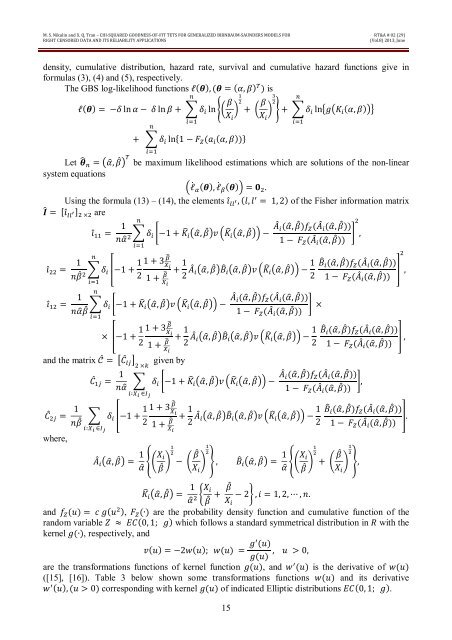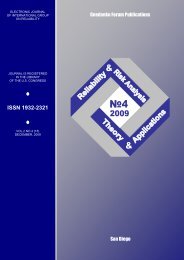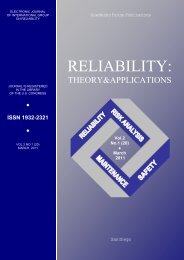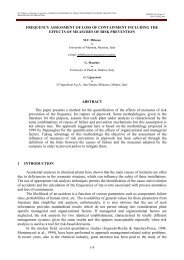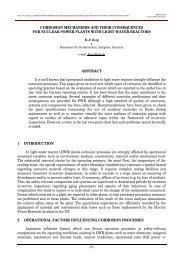7 CHI-SQUARED GOODNESS OF FIT TEST FOR GENERALIZED BIRNBAUM ...
7 CHI-SQUARED GOODNESS OF FIT TEST FOR GENERALIZED BIRNBAUM ...
7 CHI-SQUARED GOODNESS OF FIT TEST FOR GENERALIZED BIRNBAUM ...
You also want an ePaper? Increase the reach of your titles
YUMPU automatically turns print PDFs into web optimized ePapers that Google loves.
M. S. Nikulin and X. Q. Tran – <strong>CHI</strong>-<strong>SQUARED</strong> <strong>GOODNESS</strong>-<strong>OF</strong>-<strong>FIT</strong> TETS <strong>FOR</strong> <strong>GENERALIZED</strong> <strong>BIRNBAUM</strong>-SAUNDERS MODELS <strong>FOR</strong>RIGHT CENSORED DATA AND ITS RELIABILITY APPLICATIONSRT&A # 02 (29)(Vol.8) 2013, Junedensity, cumulative distribution, hazard rate, survival and cumulative hazard functions give informulas (3), (4) and (5), respectively.The GBS log-likelihood functions l(θ), (θ = (α, β) ) isl(θ) = −δ ln α − δ ln β + δ ln β β + X X + δ ln{1 − F (a (α, β))}15+ δ lngK (α, β)Let θ = α, β be maximum likelihood estimations which are solutions of the non-linearsystem equationsl̇ (θ), l̇ (θ) = 0 .Using the formula (13) – (14), the elements ı̂ , (l, l = 1, 2) of the Fisher information matrixI = [ı̂ ] × are1ı̂ =nα δ −1 + K α, βv K α, β − A (α, β)f (A (α, β))1 − F (A (α, β)) ,ı̂ =ı̂ =1nβ δ −1 + 1 21 + 3 1 + + 1 2 A α, βB α, βv K α, β − 1 21nαβ δ −1 + K α, βv K α, β − A (α, β)f (A (α, β))1 − F (A (α, β)) ×× −1 + 1 1 + 3 2 1 + + 1 2 A α, βB α, βv K α, β − 1 2 and the matrix C = C ×given by1C =C =where,nα δ −1 + K α, βv K α, β − A (α, β)f (A (α, β))1 − F (A (α, β)) B (α, β)f (A (α, β))1 − F (A (α, β)) ,∶ ∈ ,B (α, β)f (A (α, β))1 − F (A (α, β)) ,1 δ −1 + 1 1 + 3 nβ2 1 + + 1 2 A α, βB α, βv K α, β − 1 B (α, β)f (A (α, β))2 1 − F (A (α, β)) .∶ ∈ A α, β = 1 α X β − β ,X B α, β = 1 α X β + β ,X K α, β = 1 α X β + β − 2 , i = 1, 2, ⋯ , n.X and f (u) = c g(u ), F (∙) are the probability density function and cumulative function of therandom variable Z ≈ EC(0, 1; g) which follows a standard symmetrical distribution in R with thekernel g(∙), respectively, andv(u) = −2w(u); w(u) = g (u), u > 0,g(u)are the transformations functions of kernel function g(u), and w (u) is the derivative of w(u)([15], [16]). Table 3 below shown some transformations functions w(u) and its derivativew (u), (u > 0) corresponding with kernel g(u) of indicated Elliptic distributions EC(0, 1; g).


